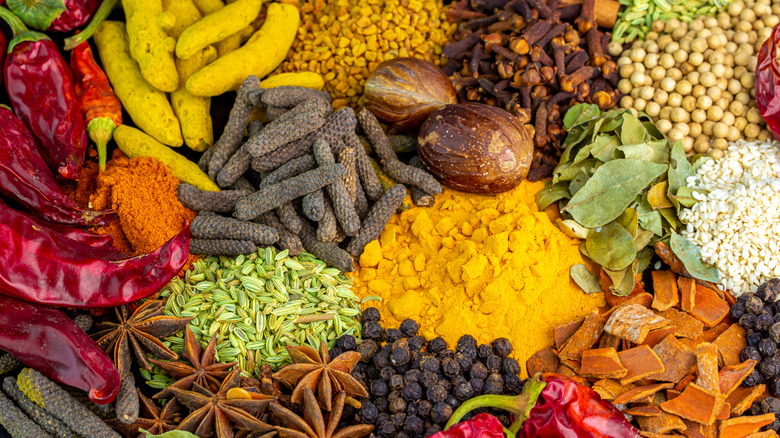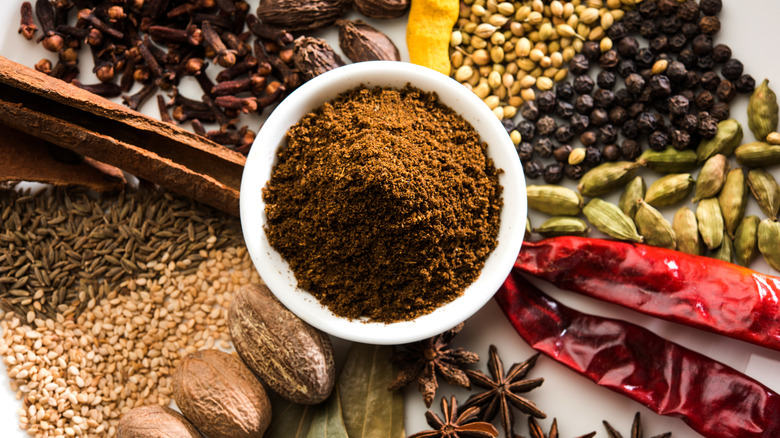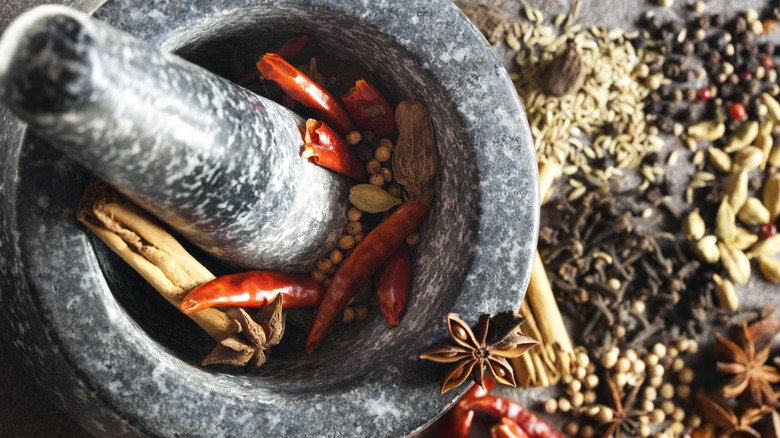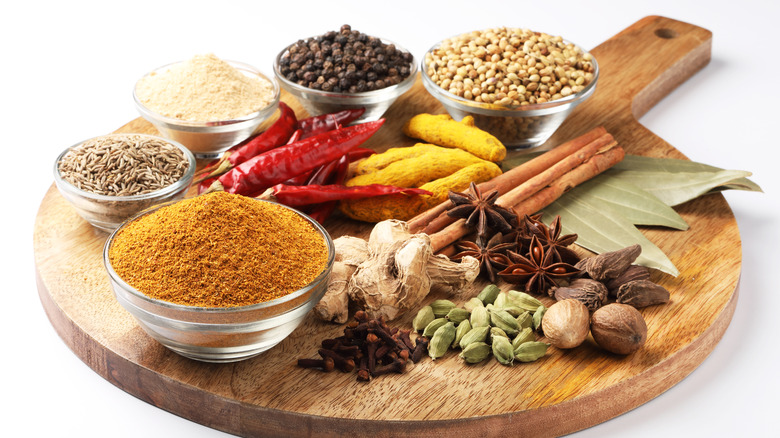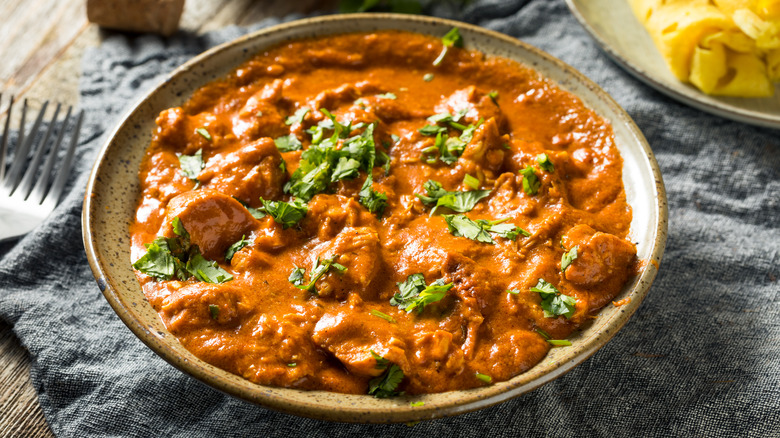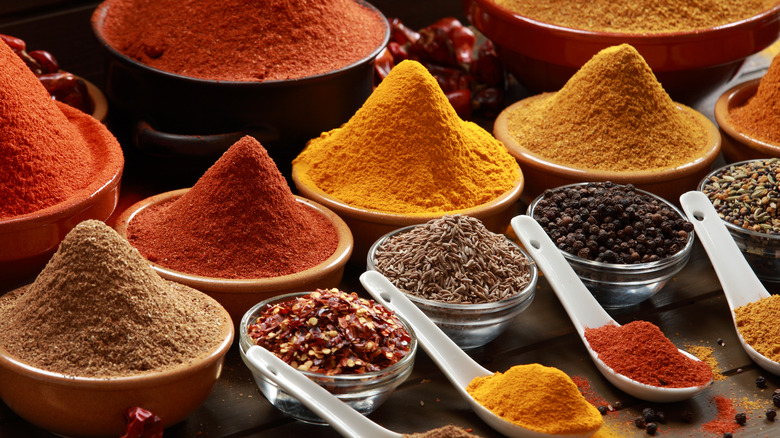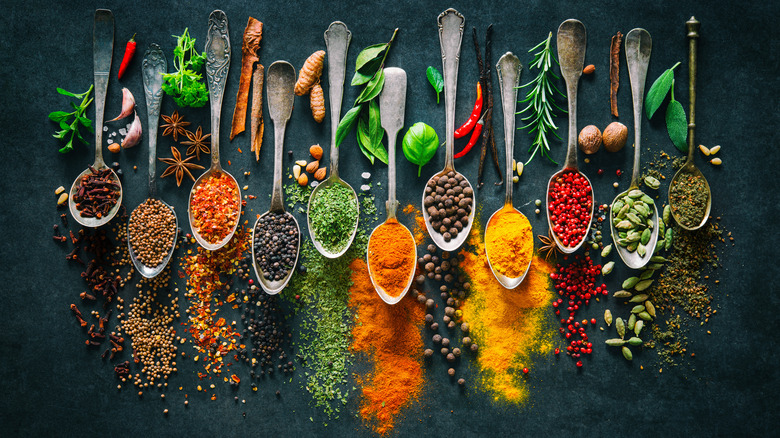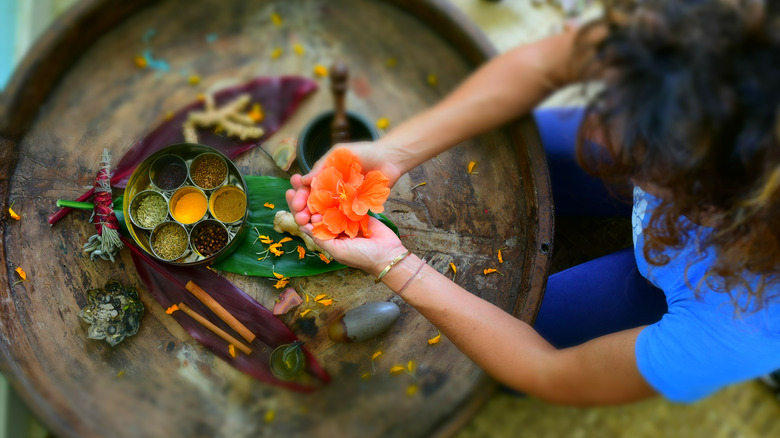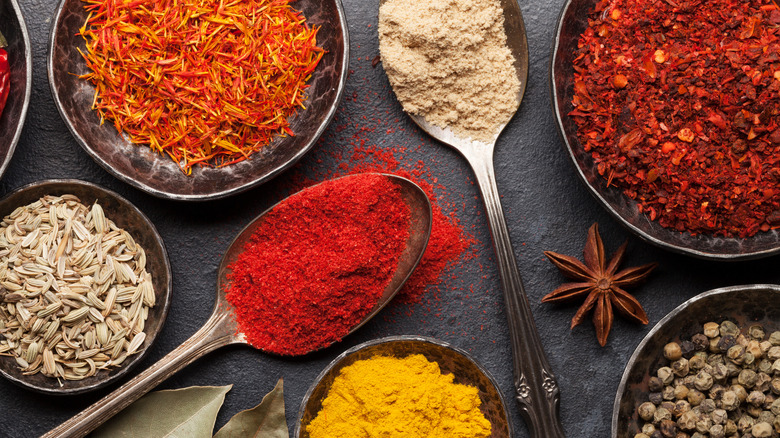What Is Garam Masala And What Does It Taste Like?
Our ultimate goal when cooking is finding ways to add depth and complexity without too much fuss. On top of trying to avoid overly complicated preparations, enhancing flavor without taking the easy route by using salt and fat is not always an easy task. Often, looking to other cultures and cuisines for tips and ideas can completely shift our perspective and introduce us to ingredients and combinations we wouldn't have come up with on our own.
Indian cuisine covers a huge range of territory and, consequently, is largely regional. Tying it all together is the artful use of spices in the majority of preparations. The value of spices has long been known, as evidenced by the McCormick Science Institute list of Ancient Empires spanning millennia who took great care in finding and using spices. Of the countless spices and blends used on the Indian subcontinent, garam masala is one that warrants highlighting. The Spruce Eats indicates that the Hindi translation of the name is hot spices. Unlike many iconic Indian dishes, hot doesn't necessarily equate to spicy, but rather, warm. The name is a hint as to what this dynamic spice blend can do for the flavor of a dish, and for your body temperature.
What is garam masala?
MasterClass reports that garam masala likely originated in the northern provinces of India, where the winter climate is cold and warming spices are necessary. The source notes that the spice blend has since spread throughout the Indian subcontinent, often becoming spicier as you head south, where it is more likely to be found as a paste instead of a powder. It is also found in neighboring countries, reaching west to Iran (via The Spruce Eats).
The number of spices used can vary widely, ranging from six to 32, per Spiceography. You'll be glad to know, many are probably spices that you are already familiar with and might use in your cooking. The Spruce Eats lists black pepper, cumin, clove, cinnamon, cardamom, coriander, nutmeg as regular components of the blend. Unlike the familiar yellow curry powder found in western supermarkets, garam masala generally does not contain turmeric. Other spices that might show up in the mix are ginger, fennel, and bay leaves, and at times, dozens more (via The Ayurveda Experience).
Local ingredients, families, traditions, and regional influences guide what spices and proportions will be used. Some people choose to toast whole spices before grinding them to add more richness, others roast them in oil, and others leave them raw — every recipe is unique. The color varies depending on the exact spices used, but an earthy, brownish hue is common.
How is garam masala made?
While you should be able to find packaged, premixed, powdered garam masala, the best is, of course, the one you grind yourself. Two Sleevers points out that whole seeds have a built-in protective shell for the oils, which immediately begin to lose freshness once it is split. Consequently, The Spruce Eats recommends keeping your garam masala in a sealed glass container up to six months, but ideally making smaller batches more frequently.
You'll need a clean coffee grinder, or a mortar and pestle if you are patient and thorough. First, decide which spices you want to incorporate and in what proportion — you can experiment by making a few blends with varying proportions to find your favorite. If you want something sweeter, you may add more cinnamon or nutmeg, whereas a spicier take would require cayenne or even a healthy dose of black pepper.
Once you've chosen your spices, decide whether you will toast them. Indian Healthy Recipes explains that doing so will help release the oils from the spices; however, there is a delicate balance between fragrant and burnt. Low and slow is the best way to monitor the spices and avoid ruining your entire batch. For ease, Indian Healthy Recipes recommends placing the roasted spices in the freezer to cool down for one to two hours before grinding. One by one, grind the whole spices separately before mixing them together in your jar.
What does garam masala taste like?
Since garam masala is a blend of spices in fluctuating proportions, every mix tastes unique and will depend largely on the individual components. Five Prana remarks that the mix is highly praised in Ayurvedic medicine and diet for its perfect balance of flavors: sweet from the cinnamon, clove, nutmeg, and coriander; bitter from the cumin; pungent from the peppercorns, cayenne, cumin, cloves, nutmeg, and cardamom; and astringent from the coriander and nutmeg.
MasterClass also mentions earthiness from the cinnamon and cumin, some zestiness from the coriander, a touch of spice from the black peppercorn, and an overall floral and aromatic profile thanks to the cardamom. Together, the spices have a notably balanced combination of savory and sweet, with a touch of spice. Of course, if you omit any of the spices or add them in greater quantities, the flavors will swing in the respective direction. For example, in southern India, where red chilis are more common, garam masala tends to veer toward a spicier blend.
Whether or not the individual spices were roasted prior to grinding will also affect the flavor. As the oils are released with heat, they provide richer depth that becomes infused into the dish you prepare. Garam masala is often not the only seasoning agent in a recipe and, therefore, works in harmony with other spices instead of overwhelming the taste of a dish.
How to cook with garam masala
Once you have prepared your blend or found a reputable pre-made mix, you are ready to cook with the spices. MasterClass explains that garam masala is used close to the end of the cooking process in order to conserve the aromatic fragrances of the spices. This is unlike curry powder, which is usually added early. You can also sprinkle some of the powder at service to highlight the warming flavors of the dish. The quantity used depends on the size of the dish and the freshness of your blend. If you only have an older or pre-packaged mix, you can increase the quantity for added flavor.
The way in which garam masala is used in cooking also differs from northern to southern India. The Spruce Eats explains that the powder form is preferred in the north, while South Indian cooking tends to use the spice mixture as a paste, by grinding it with coconut milk, garlic, and ginger. Both preparations reflect the dishes and styles of cuisine that are more common in each region.
Thanks to its natural balance of flavors, garam masala works well in a large number of dishes. The Spruce Eats remarks that it can be used with meat, fish, vegetables, soups, lentils, stews, sauces, and dips. It is part of the popular flavors associated with butter chicken and chicken tikka masala, according to MasterClass. Follow Eat This, Not That's suggestion and add a pinch to your baking for extra depth.
Where to buy the spices
For the best garam masala, you will want to grind your own from whole spices. Their quality is essential, since improperly stored spices lack freshness and any aromatic essence, resulting in a dull blend. Therefore, ordering spices from reputable sources online or purchasing them in Asian markets are probably your best options. If you don't have access or time, you'll find most of the spices sold individually in the spice or international aisle of any supermarket (via The Spruce Eats).
If blending your own spices is beyond the level of involvement you want to have before you even start cooking, you can buy prepared garam masala. Just note that you will have no say in the proportion of each spice and may have to test a few before finding one that you like. Whether you buy them separately or as a blend, choose spices that have been properly sealed and use them by their best-before date for top freshness. Once you open the packaging, The Spruce Eats recommends transferring the spices to sealed glass jars and leaving them in a dark and dry cool area.
Nutritional information about garam masala
Five Prana notes that in Ayurvedic medicine, spices are considered to be medicine, and garam masala is no exception. Since it includes a combination of spices, each one contributes its own health properties for an overall cumulative effect, clinical nutritionist Dr. Rupali Dutta tells FoodNDTV. She explains that numerous properties are reported from the blend, such as a boost in digestion and metabolism, due to the stimulation of digestive juices. A 1999 study published in Tropical Gastroenterology confirmed that garam masala led to quicker digestion times compared with spice-free meals. Meanwhile, a boost in metabolism is associated with weight loss, which Eat This, Not That indicates could be a result of the action of piperine, a compound in black pepper that is believed to limit the formation of fat cells.
According to Dr. Dutta, garam masala also contains antioxidants, which combat inflammation and improve overall health (via FoodNDTV). In addition, she points out that spices such as cinnamon are carminative, meaning they reduce bloating and flatulence, further assisting with digestion. Heart health, increased immunity, lower cholesterol, and blood sugar regulation are all reported benefits of the spice blend (via Refresh your life). Due to the variably pronounced effects of garam masala, Dr. Dutta doesn't recommend it for people with ulcers.
Garam masala's role in Ayurvedic medicine
Garam masala's role in Ayurvedic medicine should not be underestimated. According to Jeeva Lifestyle, it is considered to be a perfect balance of elements that warm the body, giving a boost to stagnant metabolisms. Indian Healthy Recipes explains that Ayurvedic medicine considers this property demonstrative of system detoxification, leading to a balance in body, spirit, and mind. The action of a detoxification mechanism as the result of eating foods with garam masala was also hypothesized in a research paper by the Indian Journal of Experimental Biology in 1992.
Depending on the particular characteristics that are thought to be out of balance, differing proportions of each spice is used. Every spice has its own health properties, and together they are believed to assist the body in maintaining proper equilibrium. The Ayurveda Experience remarks that no single garam masala blend exists, nor was any outlined in Ayurvedic writings. Therefore, as with the use of the spice blend in ordinary cooking, the source suggests that garam masala recipes were likely passed on through tradition.
Other varieties of garam masala
As discussed, spices and proportions used in garam masala blends are dictated by regional differences and individual preferences. The Spruce Eats notes that traditional northern Indian garam masala tends to be milder and resorts to black peppercorn for any spice. On the other end of the country, chili peppers are used to add fire, and the name hot spices takes on another meaning.
According to Ministry of Curry, Maharashtrian families from the western coast of India refer to a similar spice blend as "goda masala." The detailed recipe lists 20 spices, including fenugreek and poppy seeds, star anise, and turmeric, which are toasted with oil and ground to a fine powder. If you're looking for a simpler, aromatic option, Spice Chronicles recommends Bengali garam masala, which sums it up with three spices: cinnamon, cardamom, and cloves.
When choosing which variety of garam masala to use, allow the type of recipe you are making to guide you. If it is regionally associated with northern India, milder blends in powdered form will probably be a better match. If you are making a curry heavy in coconut milk, garlic, and ginger, opt for a spicier paste to match the southern style. Finally, it is essential to experiment with spice combinations, proportions, and preparations in order to find what you like the best.
